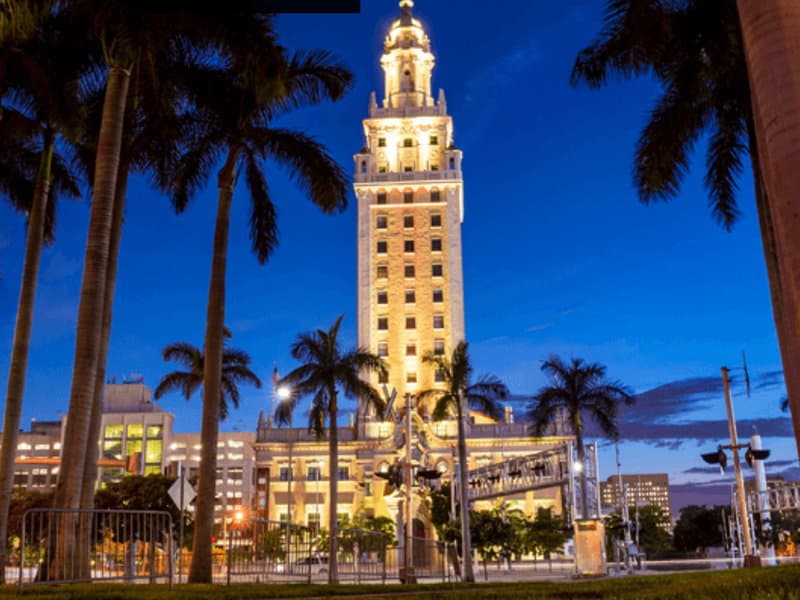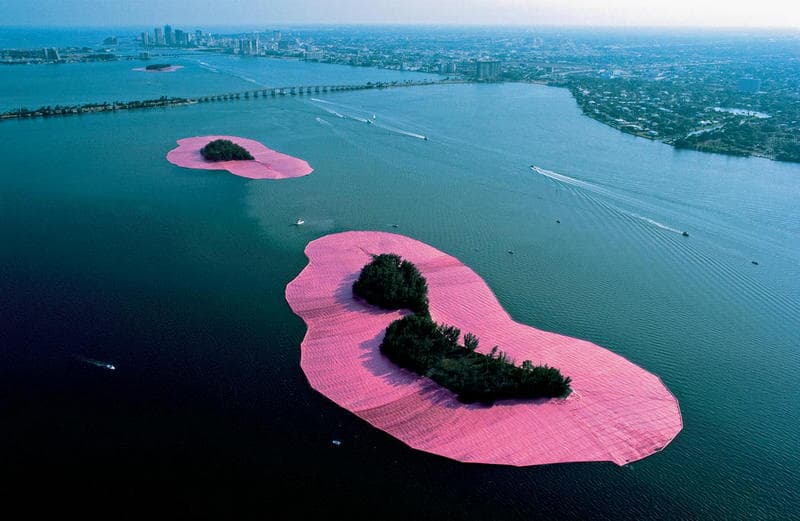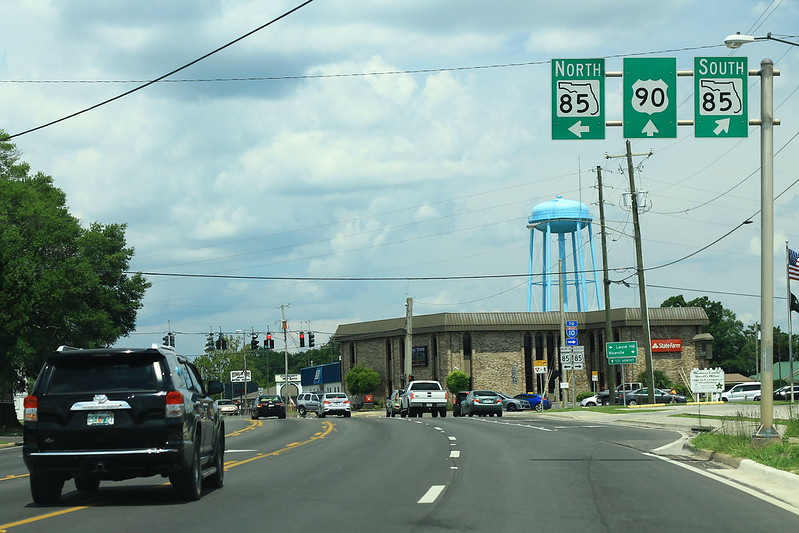- Home
- Florida Towns
- Miami
- History of Miami
THE HISTORY OF MIAMI, FLORIDA
By Mike Miller Updated December 30, 2022
The history of Miami is brief by the standards of the rest of America, but it has traveled a long way in a short time.
The area was first settled by Tequesta Indians. They lived near the mouth of the Miami River until the Spanish came along and constructed a mission there in 1567.
During the Second Seminole War, the U.S. built Fort Dallas in 1836 at the mouth of the Miami River near the location of the former mission.
This war was the beginning of the modern history of Miami Florida.
Julia Tuttle, the Founder of Modern Miami
Books on the history of Miami Florida consider Julia Tuttle to be the founder of the modern city.
She was a rich woman who originally came from Cleveland, Ohio, toward the end of the 1800's and planted citrus groves in the Miami area.
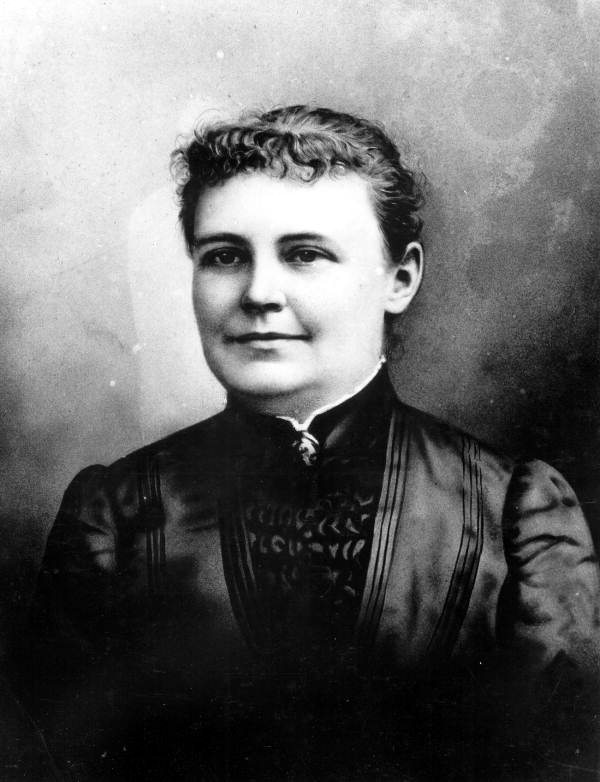 Julia Tuttle
Julia TuttleAfter Florida's Great Freeze of 1894-1895, most of the state's citrus industry was destroyed. The only citrus that survived was in the south Florida area around Miami.
This good fortune was to be the turning point in the history of Miami Florida.
Henry Flagler Brings His Railroad to Miami
Julia Tuttle was able to convince Henry Flagler to expand his Florida East Coast Railroad to Miami. The rumor is that she sent him a nice fresh orange blossom after the freeze.
Flagler was convinced, the railroad came to town, and that's when Miami Florida began to boom.
The little settlement of Miami, with a population of slightly more than 300, was officially incorporated as a city on July 28, 1896. The official history of Miami begins with that date.
The Florida Land Boom of the Roaring Twenties
Miami grew quickly through the 1920's with a huge increase in population.
This was the era of the Florida Land Boom, and places like Coral Gables, Hialeah, Miami Springs, Miami Beach and Opa-Locka became household names around America.
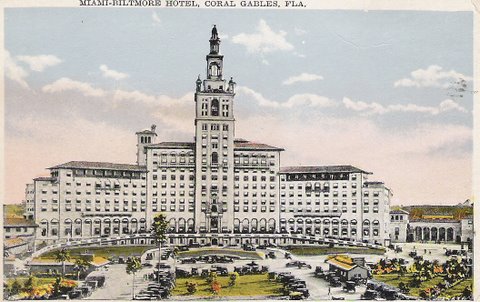
People got rich flipping real estate. They'd buy a building lot before lunch and sell it for a huge profit before dark, day after day.
The stories of quick wealth became a prominent part of the history of Miami.
The Great Hurricanes of 1926 and 1928
Hurricanes have also been part of Miami history. Click on this link for video scenes from the devastating 1926 hurricane.
The 1926 Miami Hurricane, the 1928 hurricane and the Great Depression ended the Florida Land Boom with a crash.
To this day, the history of Miami Florida is linked to the hurricane and subsequent crash.
Miami's Role in World War Two
Miami was devastated economically and would take a long time coming back.
By the early 1940's, Miami was on the way back. Many new hotels had been built, especially in Miami Beach, and the city was growing.
World War II was responsible for accelerating the area's comeback.
The history of Miami still resonates with the activities that took place here during the war.
Almost every hotel room in Miami and Miami Beach became barracks for military men and women who were being trained for the war.
The City was also well located to play a role in the search and destruction of German submarines operating off the South Florida coast in the gulf stream.
During the war, about 175,000 people lived in Miami. The history of Miami was changed forever by these people.
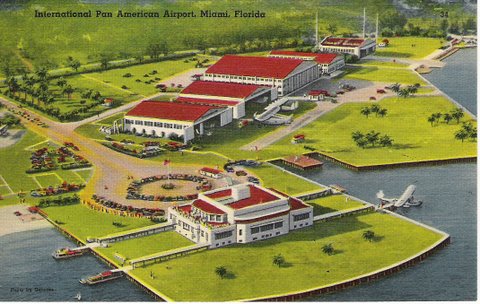 Miami Dinner Key Pan Am Terminal
Miami Dinner Key Pan Am TerminalAfter the war, many military people came back to work and live in Miami. Miami once again became a thriving city.
It was the headquarters of Eastern Airlines and Pan American Airlines.
Fidel Castro Takes Over in Cuba
Understanding the history of Miami would not be possible without studying a bit of the history of modern Cuba, our neighbor 90 miles to the south.
When Fidel Castro overthrew Batista and took over Cuba in 1959, many Cubans fled to Miami, increasing the population even more.
The Cubans were not welcomed with open arms. Signs appeared on apartments for rent in all areas of Miami-Dade County that said "No Dogs Or Cubans Allowed".
This was not the brightest period in the history of Miami.
The Anglo business and political power structure did not make things easy for the displaced Cubans.
By sticking together, and with diligence, time and hard work, the Cuban population came to be the most powerful political and economic force in Miami.
In the 1970's, 1980s and 1990s one crisis after another buffeted Miami as badly as hurricanes had done in the past. In fact, one of the crises was another hurricane.
These crises - along with one morale boosting event in between - are important to understand the history of Miami and the resilience of its people.
The Cuban Refugee Crisis
The Cuban Refugee Crisis. The 1960's saw hundreds of thousands of refugees flood into Miami from Castro's Cuba.
There was a shortage of housing for them, the city's utility and educational systems were badly strained.
It took most of the decade for the crisis to settle down and for the community to adjust to the new residents and for the new residents to become part of the community.
The Cocaine Cowboys
The "Cocaine Cowboys" emerged in the 1970's. The "cowboys" were an assortment of merciless murdering drug dealing gangs and syndicates, many of them Colombian.
Murders and violence became the norm. Floridians from the rest of the state became afraid to even visit Miami, let alone do business there.
I was having lunch one day in 1979 with a client at Neon Leon's, a then popular restaurant in South Miami.
During lunch, the owner was posting prices on a bulletin board by the front door when he was killed by gunfire from a hit man riding a motorcycle.
It was a war and it seemed like the bad guys were winning. The good guys finally got it under control, but they were scary times.
The Miami Race Riots
The Miami Race Riot of early 1980 was triggered by the Arthur McDuffie incident. McDuffie was a Black insurance salesman and a former U.S. Marine.
Early one morning in December 1979, police were chasing the 33 year old McDuffie on his motorcycle. McDuffie had several outstanding traffic citations and was driving with a suspended license.
The consequences of this arrest, including the police beating of McDuffie, resulted in one of the worst race riots in the history of Miami and America.
The Mariel Boatlift
The Mariel Boatlift between April and October 1980 was another crisis for Miami. People were starving in Cuba, and riots were taking place in Havana and elsewhere.
Fidel Castro then announced that anybody who wanted to leave Cuba could do so. The boats started back and forth between Miami and Cuba immediately.
The Miami Cuban-American community did most of the work in helping the refugees leave Cuba.
After as many as 125,000 Cubans had made the trip to Florida, it was discovered that Castro had also gotten rid of many hardened criminals from his jails, along with patients from his mental health hospitals.
The U.S. government stopped further boat lifts, but not before altering the history of Miami Florida forever.
"Marielitos" became a bad name, even though not all of them were bad. Most Cubans - Marielitos and non-Marielitos alike - did not want to be associated with this designation.
The Mariel Boatlift, along with the Iranian hostage crisis, did not help the political career of then President Jimmy Carter.
Christos Surrounded Islands
Christos Surrounded Islands was a good thing that seemed frivolous at the time.
After the misery, violence and bloodshed of the 1970's and 1980's, Miami received a morale boost in 1983. This was the year that "the surrounded islands" project was completed.
There was something healing and unifying about this project that wrapped several islands in Biscayne Bay with pink plastic.
The Eastern Airlines Bankruptcy
The Eastern Airlines Bankruptcy in 1989 after years of declining revenues and labor union problems, caused the historic airline to finally close its doors in 1991.
It was a huge shock to the community and a tragedy in the history of Miami.
The city was the headquarters of Eastern. The airline had been founded in the early days by Captain Eddie Rickenbacker, a World War One flying ace and genuine American hero.
Eastern filed for bankruptcy protection on March 9, 1989. With the airline collapsing from debt, it ran out of money to operate on January 18, 1991.
Over 18,000 employees lost their jobs and pensions in one day, not including the thousands laid off in the years prior to the final collapse.
It was a dark page in the history of Miami Florida.
The Devastation of Hurricane Andrew
Hurricane Andrew crashed into the Kendall, Homestead and Florida City areas south of Miami on August 24, 1992. It kept on going across the state and Gulf of Mexico and finally hit Louisiana.
Andrew caused $26.5 billion in damage ($40 billion in 2009 dollars), with most of that damage in south Florida.
I moved to Miami a few weeks after Andrew, and the devastation I saw was unbelievable.
Over 250,000 thousand people were homeless. 82,000 businesses were destroyed.
Electricity and water were not available to hundreds of thousands of people who still had some of their home left to live in.
I was lucky to have a boat I could live aboard at the Miami Beach Marina.
It took years for the damage to be repaired. More than 100,000 people abandoned the area when they got their insurance checks, and moved to south Broward County.
The demographics of south Miami-Dade County changed dramatically.
Andrew also had a severe impact on the environment.
It damaged 33 percent of the coral reefs at Biscayne National Park, and 90 percent of South Dade's native pinelands, mangroves and tropical hardwood hammocks.
It also produced a 30 year supply of debris for South Florida's landfills.
The Elian Gonzalez Affair
The Elian Gonzalez affair in 2000 galvanized the Cuban Americans of Miami, along with many other anti-Castro and anti-communist people in the community and the United States.
In November 1999, Elian, his mother, and twelve others left Cuba on a small boat with a bad engine. Elian's mother and ten others died in the crossing.
Elian and the other two survivors floated at sea on an inner tube until they were rescued by two fishermen who turned him over to the U.S. Coast Guard.
Attorney General Janet Reno decided that Elian should be returned to his father in Cuba. Federal agents stormed the house of Elian's relatives and took him into custody, then sent him back to Cuba.
It was a public relations triumph for Castro.
March 27, 2023 update on the life of Elian Gonzalez from the Miami Herald.
González set to be a legislator in Cuba
By Nora Gámez Torres and Grethel Aguila Miami Herald
Elián González, the Cuban boy found clinging to an inner tube near Florida shores who became the center of an international child custody dispute as well as a political battle between Cuba’s late leader Fidel Castro and Cuban exiles in Miami, is set to become a member of the island’s National Assembly after Cubans went to the polls Sunday.
González, 29, was proposed as a candidate for the municipality of Cárdenas, in Matanzas, where he lives and works as assistant director of AT Comercial Varadero, a food import company run by the Cuban Ministry of the Armed Forces.
Read more in the Miami Herald.
The Miami Homeless Population
Another continuing crisis during the 1980's and 1990's was the large homeless community camped out in makeshift shelters under the various interstate bridges in the downtown area, and under the Julia Tuttle and MacArthur Causeways.
The beauty of Miami's people and the strength of Miami is that they not only endured these crises, they solved them and became stronger because of them.
The history of Miami Florida continues to be written by these strong people.
Our Facebook page has more than 130,800 followers who love off the beaten path Florida: towns, tourist attractions, maps, lodging, food, festivals, scenic road trips, day trips, history, culture, nostalgia, and more.
By Mike Miller, Copyright 2009-2025
Florida-Back-Roads-Travel.com
Florida Back Roads Travel is not affiliated with or endorsed by Backroads, a California-based tour operator which arranges and conducts travel programs throughout the world.
